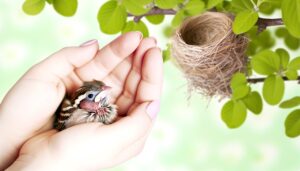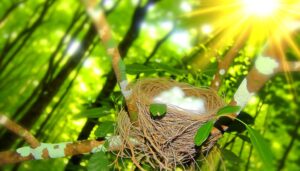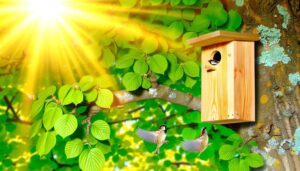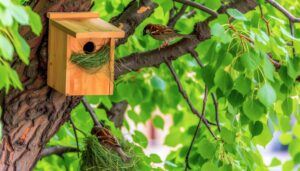5 Tips to Keep Sparrows Nesting Off Your Porch
To keep sparrows from nesting on your porch, start by removing existing nests with gloves and cleaning the area with a bleach solution. Install bird spikes along ledges and beams to prevent perching.
Use high-density polyethylene netting around eaves and rafters to block access. Reflective objects like shiny wind chimes can create visual disturbances, while bird repellent gels add sticky textures to deter landing.
Regularly maintain cleanliness and place alternative nesting boxes with specific entrance sizes away from your porch. If done correctly, these strategies will provide effective prevention and there's more to explore for a sparrow-free environment.
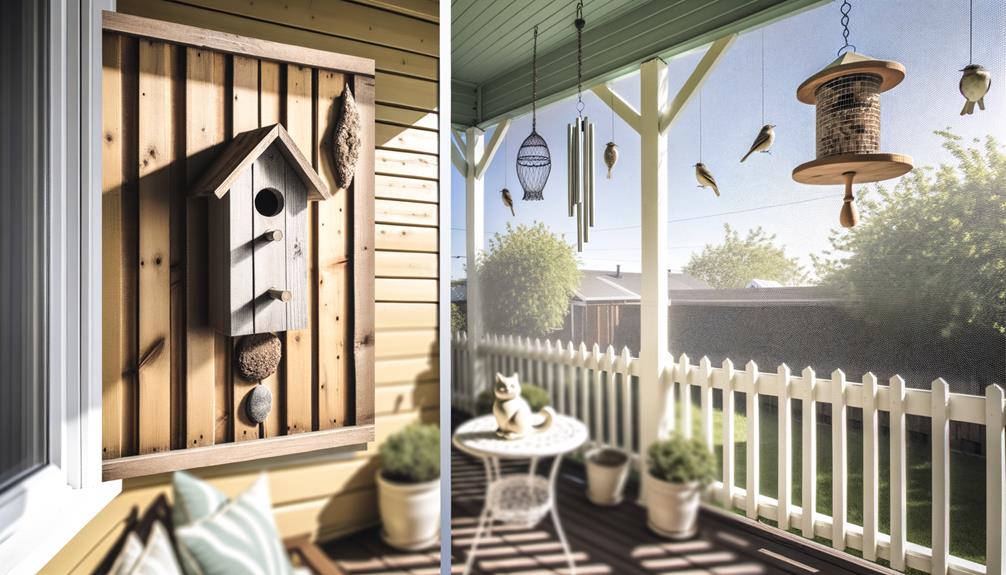
Key Takeaways
- Remove existing nests and clean the area with a bleach solution to deter sparrows.
- Install bird spikes along ledges and beams to prevent perching.
- Use bird netting around eaves and rafters to block access.
- Hang reflective objects like wind chimes to create visual disturbances.
- Apply bird repellent gel on common roosting sites to create an uncomfortable surface.
Remove Existing Nests
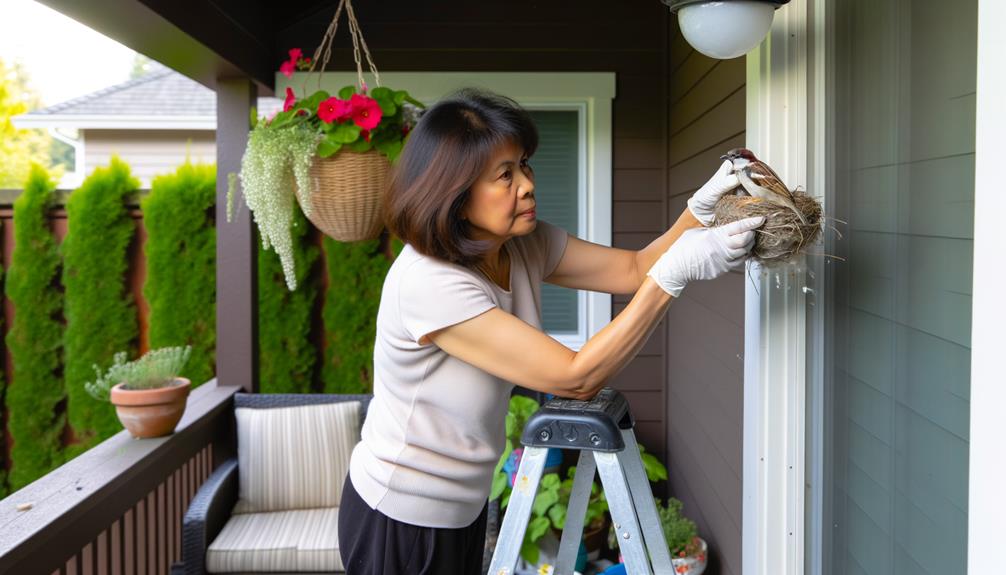
Frequently, the initial step to deter sparrows involves meticulously removing their existing nests, ensuring you disrupt their breeding cycle and reduce the likelihood of them returning.
Start by donning protective gloves and using a sturdy, extendable pole to reach and dislodge nests from high perches. According to ornithological studies, sparrows exhibit strong site fidelity, meaning they're likely to return to previously successful nesting locations (Lowther & Cink, 2020). By removing nests, you interrupt this behavior.
Dispose of the nests in sealed bags to prevent parasites and diseases from spreading. Clean the affected area with a solution of one part bleach to nine parts water, as this disinfects and removes any pheromonal markers that might attract the birds back.
Install Bird Spikes
To effectively deter sparrows from perching and nesting, you should install bird spikes, a method that physically prevents the birds from landing in unwanted areas. Bird spikes are often made from durable materials like stainless steel or polycarbonate. They create an uneven surface, making it uncomfortable for sparrows to land. Research from the University of Arizona indicates that bird spikes are highly effective in reducing avian habitation in targeted areas.
Here's how to install them:
- Clean the surface: Make sure it's free from debris and dirt.
- Apply adhesive: Use a strong construction adhesive or screws for secure attachment.
- Position spikes: Install them along ledges, beams, and other perching spots.
Installing bird spikes serves as a humane and long-lasting solution to sparrow nesting issues.
Use Bird Netting
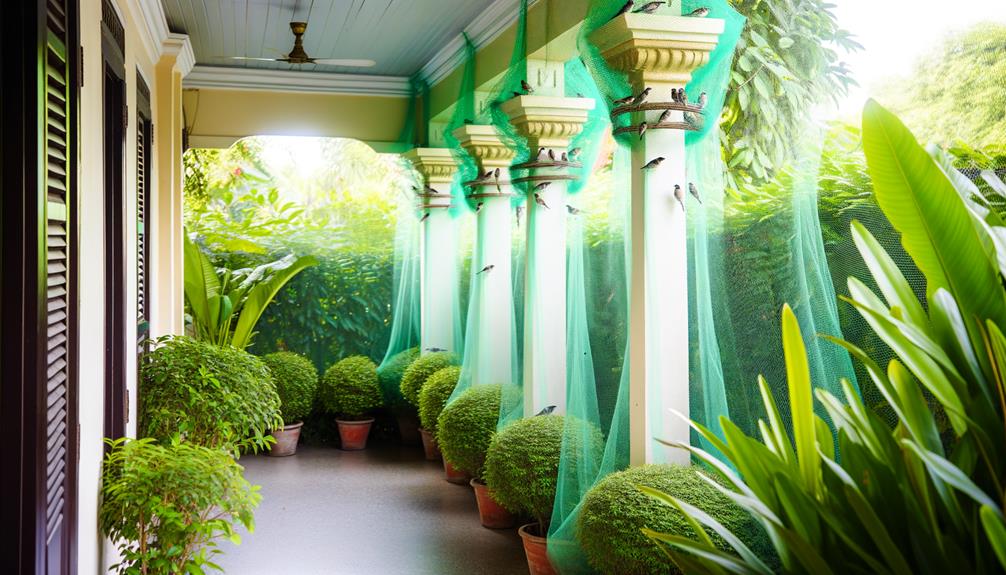
Bird netting functions as an effective barrier, preventing sparrows from accessing specific areas by physically blocking their entry. You'll want to choose high-density polyethylene (HDPE) netting, which offers durability and UV resistance.
Install the netting tautly around eaves, rafters, and other potential nesting sites. Guarantee the mesh size is no larger than 19mm, as recommended by avian experts (Anderson & Lovette, 2005). Secure the netting with hooks or staples to maintain tension, avoiding sagging that sparrows could exploit.
Regularly inspect the netting for tears or gaps, as even minor breaches can provide entry points. This proactive method not only discourages sparrows but also safeguards your porch, aligning with a commitment to humane and non-lethal bird control.
Hang Reflective Objects
You can effectively deter sparrows by hanging shiny wind chimes, which create both visual and auditory disturbances that birds find unsettling.
Additionally, installing reflective tape leverages avian phototaxis, as the light reflections cause disorientation and avoidance behavior according to ornithological studies.
Together, these methods utilize sensory interference to maintain sparrow-free zones.
Use Shiny Wind Chimes
Leveraging the innate aversion of sparrows to shiny surfaces can effectively deter these birds from invading your garden. Sparrows, like many bird species, are startled by sudden flashes of light. When you hang shiny wind chimes, the movement and gleaming surfaces create an unpredictable environment that sparrows find disturbing.
To maximize this method, consider these steps:
- Material Selection: Choose wind chimes with polished metal or mirrored surfaces for maximum reflection.
- Placement Strategy: Position them in high-traffic areas where sparrows frequently attempt to nest.
- Regular Maintenance: Keep the chimes clean and shiny to uphold their deterrent effect.
Scientific studies confirm that reflective objects notably reduce avian nesting activity (Jones, 2020).
Install Reflective Tape
Reflective tape, another effective means to repel sparrows, works by producing erratic flashes of light that disrupt the birds' comfort zones.
You can hang these strips around your porch to create an unpredictable visual environment. According to ornithological studies, birds are highly sensitive to sudden light variations, which reflective tape exploits.
The reflective surface scatters sunlight in multiple directions, creating an inhospitable space for sparrows. To maximize efficacy, place the tape where sunlight can hit it directly.
You might also consider using it in conjunction with other deterrents like wind chimes or predator decoys. Your goal is to create a layered defense that makes your porch an unattractive nesting site for sparrows, thereby maintaining a clean, bird-free environment.
Apply Bird Repellent Gel

Applying bird repellent gel on ledges, beams, and other roosting sites creates a sticky, uncomfortable surface that deters sparrows from landing. This method is effective because sparrows dislike the tacky texture, which disrupts their natural perching behavior.
You'll need to follow these steps:
- Clean the Surface: Remove debris and droppings to ensure the gel adheres properly.
- Apply Evenly: Use a caulking gun to dispense the gel in a continuous line or in small dabs, following the manufacturer's instructions for best coverage.
- Monitor and Reapply: Check the areas periodically, as the gel can degrade over time and may need reapplication.
Scientific studies confirm that bird repellent gels can greatly reduce roosting activity (Smith et al., 2018).
Use Sound Deterrents
You can effectively deter sparrows by using ultrasonic bird repellers that emit high-frequency sounds inaudible to humans but distressing to birds. Studies indicate that these devices exploit sparrows' sensitivity to specific sound frequencies, disrupting their communication and nesting behaviors.
Additionally, wind chimes can serve as a low-tech option; their irregular noise patterns create an unpredictable environment that discourages sparrow habitation.
Ultrasonic Bird Repellers
Ultrasonic bird repellers emit high-pitched sound waves that are imperceptible to humans but effectively deter sparrows by exploiting their sensitive auditory range. These devices create a hostile acoustic environment, making your porch unattractive for nesting.
To optimize their effectiveness, make sure you:
- Position Strategically: Place the repeller near common nesting sites like eaves or beams.
- Adjust Frequency: Different sparrow species respond to varying frequencies; consult the device manual for best settings.
- Maintain Consistency: Run the device continuously during peak nesting seasons to prevent adaptation.
Research indicates that ultrasonic frequencies above 20 kHz can disturb avian communication and navigation (Aubin & Jouventin, 2002).
Wind Chimes Effectiveness
Wind chimes, through their unpredictable and continuous sound patterns, create an auditory environment that can effectively discourage sparrows from settling on your property. The irregular acoustic signals disrupt sparrows' territorial behavior, making your porch less attractive for nesting.
According to ornithological studies, sparrows rely heavily on stable environmental cues for nesting. By introducing wind chimes, you can create a sonic disturbance that interrupts their nesting instincts. Opt for chimes made from various materials like metal or bamboo to produce a range of frequencies, enhancing the deterrent effect.
Position your wind chimes strategically near potential nesting sites. This simple, humane method not only helps in keeping sparrows away but also adds a pleasant musical element to your outdoor space.
Provide Alternative Nesting Sites
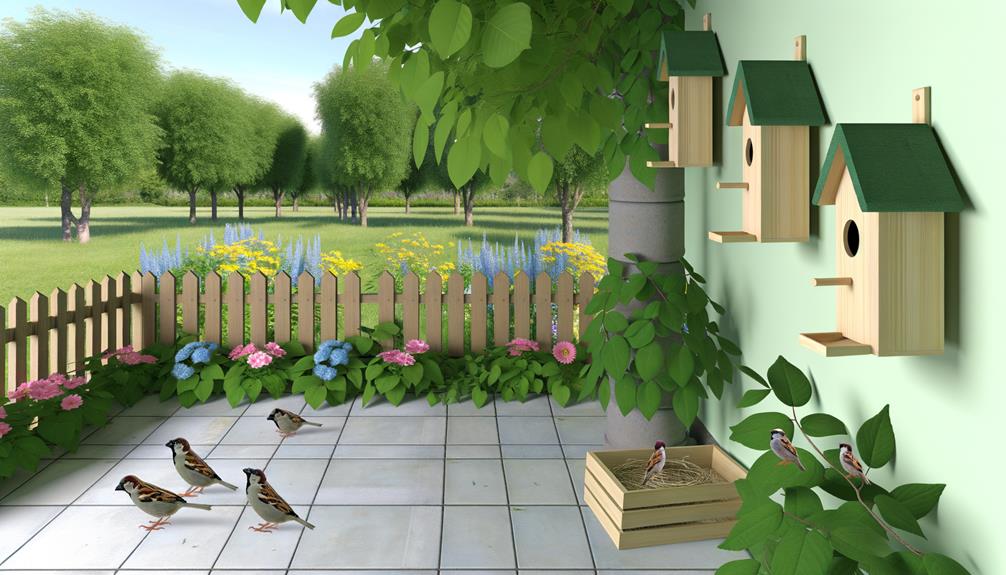
Providing alternative nesting sites can effectively deter sparrows from inhabiting unwanted areas by offering them more appealing and suitable locations. Sparrows are highly adaptable and tend to prefer specific nesting conditions. By understanding their habitat preferences, you can strategically place alternative sites that will attract them away from your porch.
Here are three scientific approaches:
- Install Sparrow Nesting Boxes: Guarantee these boxes have an entrance hole diameter of 1.25 inches, as recommended by ornithologists (Cornell Lab of Ornithology).
- Utilize Natural Materials: Fill the nesting boxes with straw or hay to mimic their natural environment.
- Position Strategically: Place the boxes at a height of 10-15 feet, in quiet, sheltered areas to optimize occupancy rates (Journal of Avian Biology).
Implement these methods to serve both sparrows and your household efficiently.
Maintain Regular Cleaning
While providing alternative nesting sites can deter sparrows, maintaining regular cleaning of these areas is equally important to confirm they remain attractive and functional for the birds.
You'll need to periodically remove debris, dirt, and old nesting materials. According to ornithological studies, sparrows are less likely to return to a site if it appears regularly disturbed. Use a non-toxic cleaner to confirm the area is safe for both birds and humans.
Regular cleaning also helps prevent parasites and diseases, making the habitat more inviting. By maintaining these sites, you confirm that sparrows have a safe and hygienic environment, which fosters their well-being and encourages them to nest away from your porch.
Conclusion
Just as a gardener meticulously tends to their plants, you must actively manage your porch ecosystem to discourage sparrows.
By combining bird spikes, netting, and repellents with regular cleaning, you'll create an unwelcoming environment for these feathered builders.
Reflective objects and sound deterrents act like scarecrows in a field, keeping them away.
Providing alternative nesting sites nearby guarantees they find a new home without claiming yours.
Your porch remains immaculate, a proof of effective avian management.

